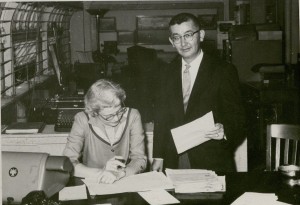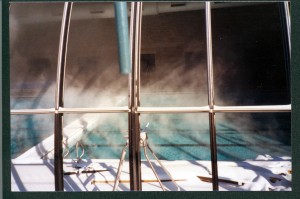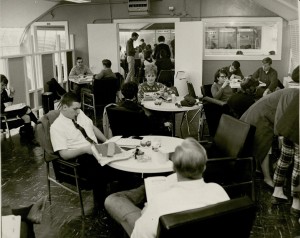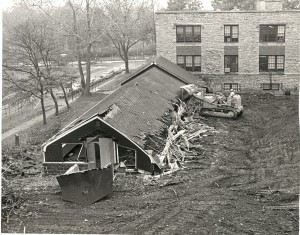After the preschool closed the greenhouse sat idle for close to a year. In the fall of 1951 though it became retrofitted with a new interior, new doors and locks, and bars on the windows. Why all this security for the greenhouse? Because it’s new purpose was as the university’s business office – handling the financial affairs of UKC.
And the man handling those affairs was Sadayuki Mouri – a UKC alumnus and a man who would go on to have a long although somewhat unsung career at UKC.

Christopher Wolff, General Merchandise Manager for the UMKC Bookstore is a UKC/UMKC Historian and someone who has researched the life of Mr. Mouri – nicknamed “Suds” by all at the university – so Mr. Wolff is providing a guest post here about Mr. Mouri and his time at UKC… So I’ll turn the post over to him now:
In the aftermath of Pearl Harbor and the United States’ entry into the Second World War, President Roosevelt issued Executive Order 9066, which enabled the relocation of Japanese Americans on the west coast of the United States to internment camps. President Robert G. Sproul of the University of California wrote to colleges and universities across the country asking if they would be willing to accept some of the displaced Japanese American university students, who were being removed to the camps with their families. One of them men he reached out to was President Clarence Decker of the University of Kansas City, who agreed to accept some of these students. The first to arrive was Sadayuki “Suds” Mouri in the fall of 1943.
Suds was born in Watsonville California in 1921. His parents had come from Hiroshima, Japan in 1918 and like many Japanese immigrants at the time had settled in the agricultural heartland of central California. He was a junior majoring in French at San Jose State University when he and his family were moved to the Heart Mountain Relocation Center near Cody, Wyoming. There he was sponsored by a Quaker relief organization, which helped negotiate his move to Kansas City. In those days before the university had a residence hall, most out-of-town students rented rooms in nearby homes. The Deckers, fearing that prejudice might make this type of housing problematic, agreed to board Suds in their own home and allowed him to pay for his room, board and tuition by performing odd jobs for the university such as cleaning, chauffeuring and assisting with events. Suds quickly endeared himself to the university community and was popular among the students. He was elected secretary of the Alpha Phi Omega service fraternity and treasurer of the French Club. Through interaction with Suds and the other Japanese American students, who eventually arrived, the university’s students were able to gain a different perspective of Japanese Americans that was far different from the images prevalent in the media of the time.
After Suds graduated in the spring of 1944 with a Bachelors in Foreign Languages, he decided to enlist in the army. President Decker told him that if he should ever want to return to the university a job would be waiting for him. He was trained as a Japanese interpreter and served on General MacArthur’s staff during the American occupation of Japan. There he witnessed firsthand the devastation of his family’s ancestral city of Hiroshima and he interviewed many of the survivors as part of his work with the army. He was discharged in 1946 with the rank of Technical Sergeant.
When he returned to civilian life Suds married Martha Nitao, whom he had met at the Heart Mountain camp. They lived in Chicago a short time before he decided to take President Decker up on his offer and return to the university in 1947 as an assistant in the Bursar’s (Cashier’s) Office. In 1954 he was promoted to Head Bursar and in 1957 the trustees made him the supervisor of the university’s budget.
He would eventually leave the university in 1961 to become the business manager for the Chicago Theological Seminary. He was later the Vice President of Business Administration at Garrett Evangelical Theological Seminary in Evanston, Illinois where he worked until his retirement in 1986. Sadayuki “Suds” Mouri passed away on June 17th, 2005.





